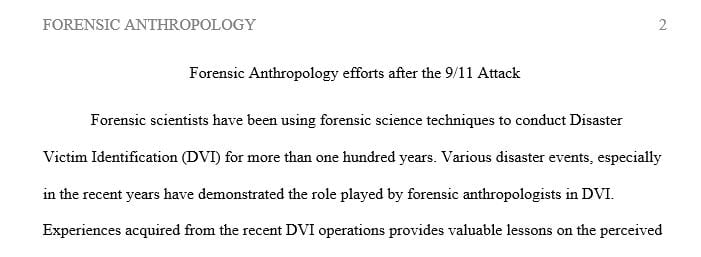Forensic anthropologists work on current criminal investigations and historical questions.
Purpose:
The goal of this exercise is to apply your knowledge about recovery techniques, lab techniques, results analysis to a modern case. Throughout the course we have discussed how modern forensic anthropologists work within medicolegal contexts to help identify human remains in a number of contexts. The student will choose one particular case associated with a forensic anthropologist (or forensic anthropologists). Students will examine the role of the forensic anthropologist throughout the case from recovery to final report and/or testimony.
Description:
Forensic anthropologists work on current criminal investigations and historical questions. For this assignment, the student will choose one modern forensic case and the forensic anthropologist who is/was associated with the case (Choose 9/11 World Trade Center Attack in the United States). The student will systematically identify the role of the forensic anthropologists in the recovery efforts, describe the laboratory techniques and analysis methods that the forensic anthropologist used to identify the victim(s) and the circumstances of their death. Students will conclude their assignment by discussing how and if this particular case made an impact on our understanding of forensic anthropology or forensic science. Students have complete creativity in this assignment and may choose any number of modern cases that interest them. The important consideration is that the case be modern (for example: Casey Anthony murder trial, Amanda Knox murder trial, O.J. Simpson murder trial) or be an old case revisited by a modern forensic anthropologist (examining the remains of Francisco Pizzaro, or Czar Nicholas II).
Write a 6-8 page narrative that includes the following:
1. Case background
a. Identify the specific case your final project will focus on.
b. Summarize the event. When and where did it occur? Who was the victim?
2. The role of the forensic anthropologist
a. Identify the forensic anthropologist involved in the case.
· There may be more than one, particularly if this is related to a criminal investigation
· If a certified forensic anthropologist was not clearly involved in the case, you may also describe the medical examiner or coroner instead. Keep in mind that you will want to focus on the methods/techniques/analyses that we studied in this class. If you only find information about a forensic botanist that will probably not be useful for this write-up and you may need to choose a different case.
b. Identify the role of the forensic anthropologists involved. Was the forensic anthropologist used in recovery and analysis? Discuss their role in the case.
c. Discuss the forensic anthropologist’s findings
§ Recovery of remains: describe the findings (if applicable).
§ Individual identification: what material did they have? What were some of the methods that they used?
§ Antemortem analysis: what information was determined about the antemortem health or condition of the victim(s)? How did the forensic anthropologist determine this?
§ Postmortem analysis: what information was determined about the time of death and cause of death? How did the forensic anthropologist determine this?
§ Novel methods or analysis: what novel methods or analyses did the forensic anthropologist use in this case (if applicable)?
2. Significance and ethics
a. What was the overarching significance of this case?
b. Did this case lead to new discoveries or technologies in forensic anthropology?
c. Was the forensic anthropologist’s report called into question? Was their testimony and/or report a more neutral piece of evidence in the case?
4. Works cited
a. Include two additional outside sources (no dictionaries or encyclopedias) in your write-up. For part 2 of the assignment details, you will likely want to consult courtroom reports or websites detailing the evidence presented in the case. You may be able to find transcripts of some testimony that is also helpful. You should both cite the sources to demonstrate how you used the sources in your assignment and also provide references. You should not use collaborative or personal opinion sources such as blogs, social networking pages, Wikipedia, Ask.com, Answers.com, Ehow.com, Encyclopedia Britannica, etc.
Grading Rubrics
Each assignment is graded based on specific elements elements. The rubric notes the element, the number of points each element is worth, a description of what that element looks like based on very good to poor work, and the points received based on how good your work is.
Disclaimer
Originality of attachments will be verified by Turnitin. Both you and your instructor will receive the results.
Writing Expectations
All written submissions should be submitted using APA-style formatting. In part, this includes:
Typewritten in double-spaced format with a readable style and font and submitted inside the electronic classroom (unless classroom access is not possible and other arrangements have been approved by the professor).
Arial 11 or 12-point font or Times New Roman styles.
Page margins Top, Bottom, Left Side and Right Side = 1 inch, with reasonable accommodation being made for special situations and online submission variances.
Citation and Reference Style
Assignments completed in a narrative essay or composition format must follow APA citation style.
Answer preview to forensic anthropologists work on current criminal investigations and historical questions.
APA
2309 words



